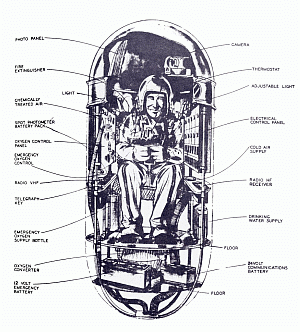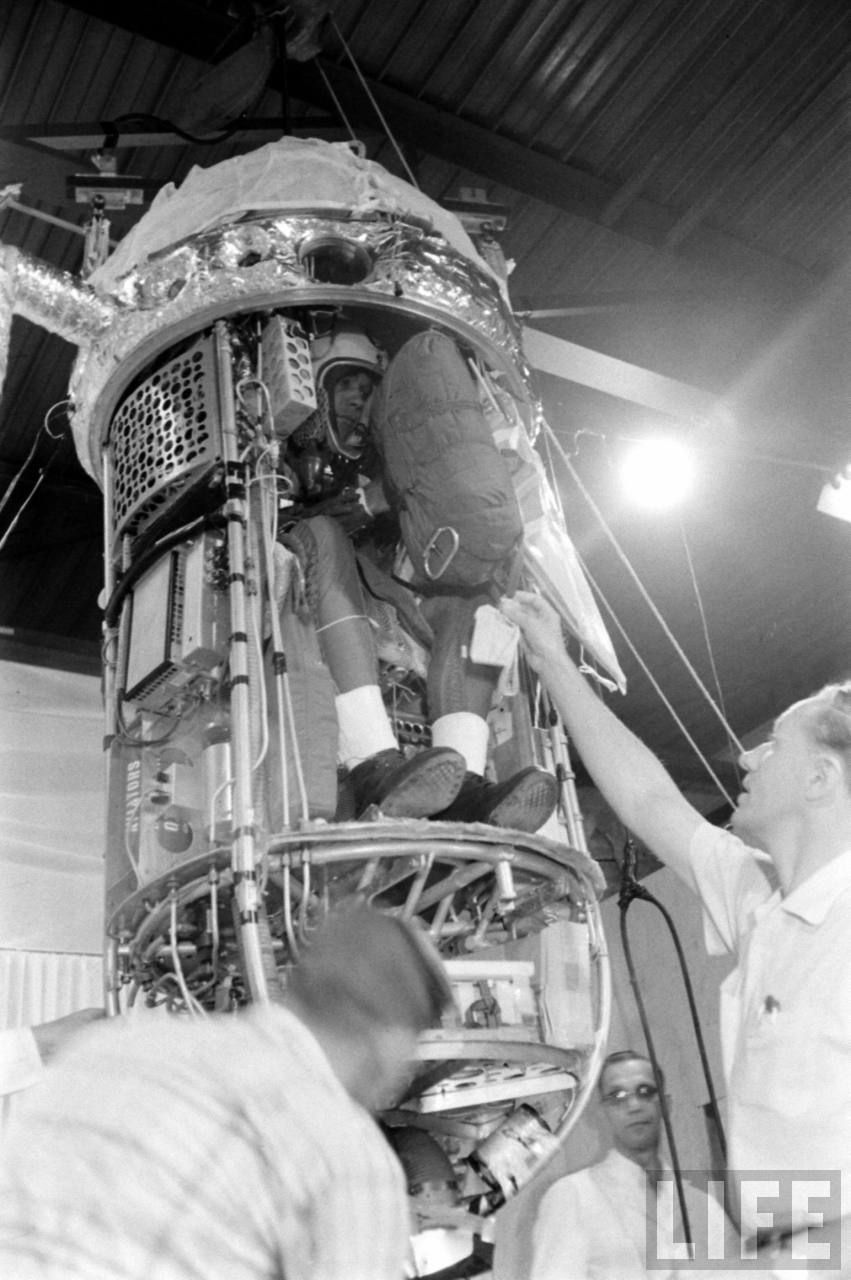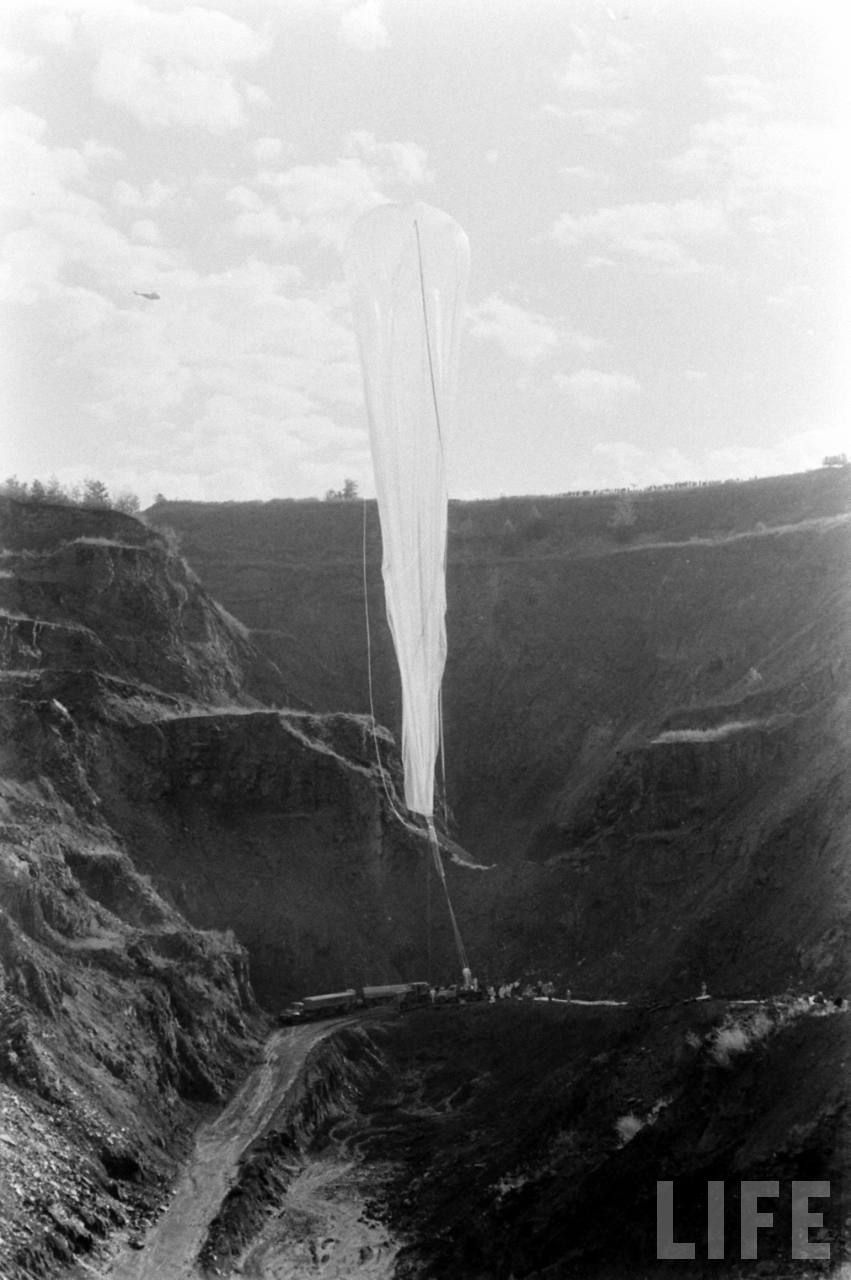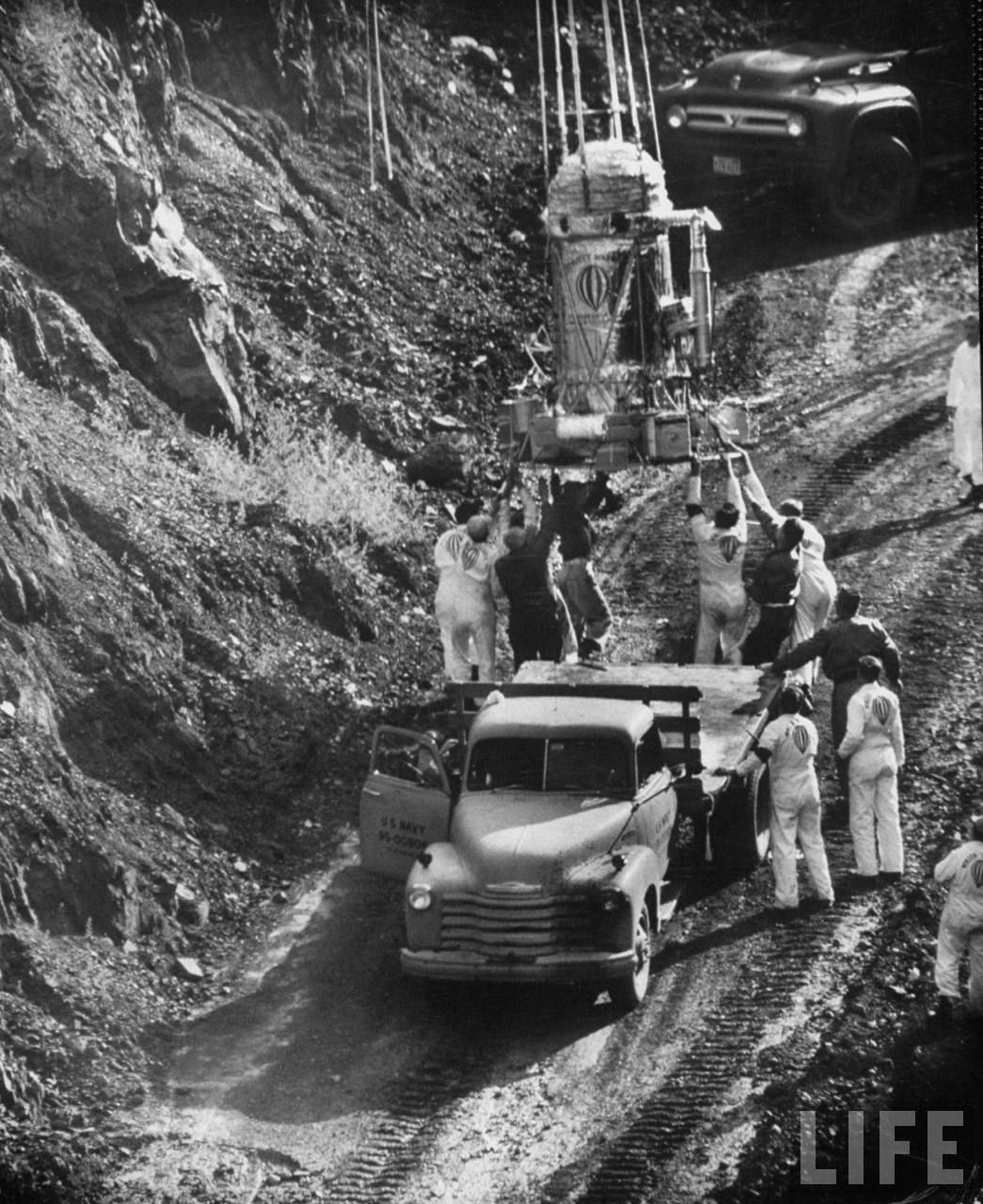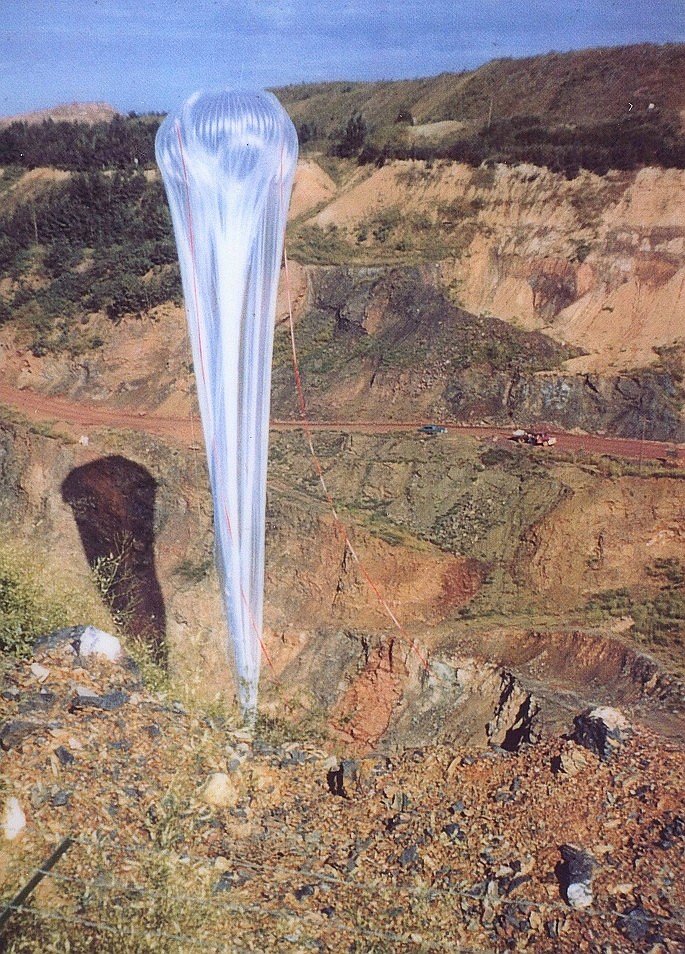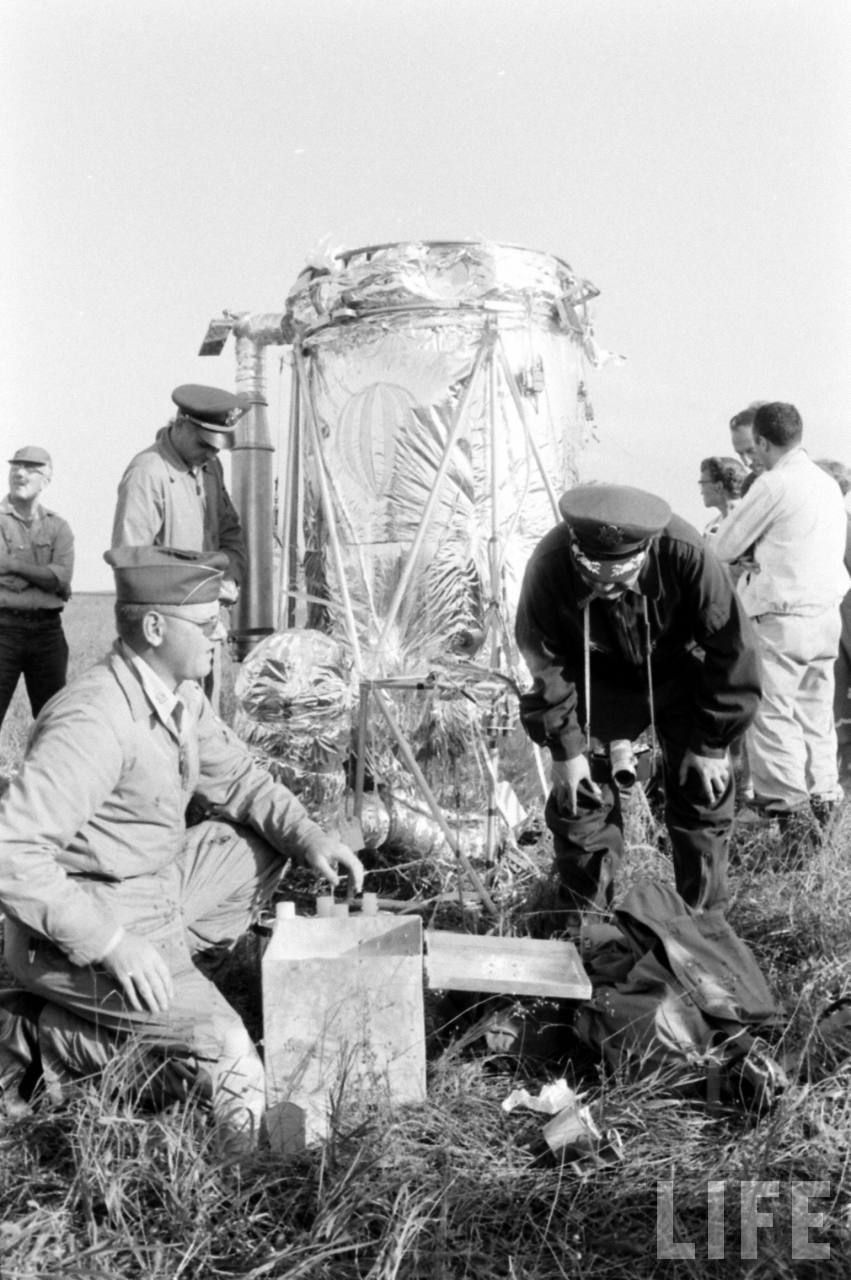Purpose of the flight and payload description
Project Manhigh was a United States Air Force balloon flight program designed to investigate the human factors of space flight by taking men into the stratosphere. Since space is considered a hostile environment, in the middle 50's the Air Force needed to know how humans could survive there and sought to discover more of the design principles for space capsules and how to study men and their reactions when in space. The collection of such data would permit intelligent planning of future space flight experiments.
Dr. John P. Stapp, who was then chief of the Aeromedical Field Laboratory, Air Force Missile Development Center, had approved the project at the local level and forwarded it through channels to obtain the necessary headquarters approval. Dr. David G. Simons of the Aeromedical Field Laboratory, was appointed the Air Force Project Officer.
Contracts for the construction of the balloon and capsule, the balloon training of the pilots and the launch support were let to Winzen Research Inc., Minneapolis, Minnesota. Planning was jointly conducted by Holloman AFB and Winzen personnel.
As the Air Force has always considered safety to be paramount, before men were allowed to ascend in the capsule, there were six unmanned flights to test all portions of the system. Also the pilot went trought a hard preparation including a parachute jump, a 24 hour claustrophobia test in the capsule, and numerous ground tests using the capsule climate control system, including a test in the high-altitude, low-temperature test chamber at Wright Air Development Center (now Wright-Patterson AFB).
The capsule used in the project was basically the same with some improvements from flight to flight (click over the top image to see a detail of it). It was an aluminum-alloy, hermetically-sealed unit 8 feet high and 3 feet in diameter, with hemispherically-shaped ends. The capsule was supported in an upright position by a tubular aluminum structure with various expendable equipment attached. This structure was especially designed to serve as a shock-absorbing system during landing operations. The capsule shell was constructed of three separate sections hermetically sealed together by two circumferential clamps. The turret casting, with six portholes, was the load-carrying member for almost all the internal structure and equipment.
The capsule was attached to an open, 40.4 foot extended skirt parachute with six suspension fittings positioned circumferentially around the turret casing. The parachute was, in turn, attached to the balloon by a stabilizing suspension system to retard any capsule oscillations during the flight.
The internal pressure of the capsule was the equivalent to that of 26,000 feet, line oxygen for the pilot's breathing and for cabin pressurization was provided by a 5-liter liquid oxygen converter and a 205-cubic-inch, high-pressure bottle. An emergency 90-cubic-inch bailout supply was installed in the personal parachute harness worn by the pilot. The sealed atmosphere in the capsule was chemically treated to remove carbon dioxide and moisture, and an external water evaporation cooling system was used to maintain the capsule temperature at a comfortable level.
Electrical and communications equipment was primarily installed inside the capsule. The main exception was the lead acid battery power supply. The batteries, mounted on the lower undercarriage ring and equipped with individual parachutes, were used as ballast when expended. In addition to the battery ballast, fine control was made possible by dropping steel shot through a metering valve mounted below the ballast container.
Manhigh II used the same capsule configuration as that of Manhigh I, with some changes about from data obtained from the first flight. The pilot of Manhigh I had complained about the relatively low level of illumination inside the capsule at altitude. The Manhigh II capsule, therefore, represented the first attempt at astrochromatics, the interior decoration of a space ship. The upper hemisphere was painted white on the inside over-layer of insulation material. The various emergency controls were color-coded, as were the portholes and instrument panels.
Pastel colors of restful hues were chosen to generate a feeling of a pleasant, cheerful surrounding. Tests showed the illumination resulting from the white hemisphere in Manhigh II was roughly three times as high as that resulting from the light blue surface used in the Manhigh I upper hemisphere. The balloon vehicle used for the Manhigh II flight represented the largest plastic balloon in production at that time. It had a volume in excess of three million cubic feet and at ceiling altitude reached a diameter of 200.2 feet. It was constructed of 1.5 mil gage (0.0015 inch) polyethylene.
The pilot's seat was the first operational application of an integrated body support system for the achievement and maintenance of optimum comfort and accommodation over an extended period of time.
Special instrumentation was added as required by the Fédération Aéronautique Internationale for the purpose of establishing an official world's altitude record, and also was fitted out with a five-inch telescope for astronomical observations, another noteworthy new item of equipment.
This second flight included a battery of at least twenty-five distinct scientific experiments to be performed involving everything from physical data on the upper atmosphere to whatever psychological reactions the pilot might wish to transcribe on the capsule's tape recorder. The most important single scientific instrument was Major Simons himself. He was subjected to complete physical examination in order to establish a basis of comparison with his post-flight physical condition. This included blood and urine samples to be compared with post-flight samples. Photographic plates were taped to his arms and chest to record the impact of cosmic ray particles in an effort to determine if they would have adverse effects on the pilot. Instrumentation also recorded his pulse and respiration rates.
Dr. Simons almost had a copilot on his flight; at one point it had been decided to send up a monkey in the capsule, not so much to keep Dr. Simons company, but to provide another cosmic radiation test subject. The monkey had already been selected and shipped to Wright Air Development Center for a final chamber test of the capsule. However, at this point, Dr. Stapp grounded the monkey and Dr. Simons went up solo.
Video of preparation of the capsule and launch from the open mine pit
Details of the balloon flight
Balloon launched on: 8/19/1957 at 9:22 cdt
Launch site: Portsmouth Mine, Crosby, Minnesota, US
Balloon launched by: Winzen Inc. / HAFB
Balloon manufacturer/size/composition: Zero Pressure Balloon Winzen - 3.000.000 cuft
End of flight (L for landing time, W for last contact, otherwise termination time): 8/20/1958 at 17:32 cdt
Balloon flight duration (F: time at float only, otherwise total flight time in d:days / h:hours or m:minutes - ): 33 h 10 m
Landing site: In an alfalfa field near Frederick, South Dakota, USA
Campaign: MANHIGH
This was the second flight of the program and was piloted by Major David Simons, at the time was part of the Aeromedical Field Laboratory, and also was the Air Force Project Officer for project MANHIGH.
The mission started at 22.00 CDT on 18 August 1957 when Simons seated in the capsule at the Winzen Research Inc. plant in Minneapolis. After completion of the checklist, the capsule with the pilot inside was lifted into the air and lowered into its shell at 23:45. The usual cap of dry ice was placed on top of the capsule for cooling purposes, and the process of elimination of nitrogen from the atmosphere was begun. Then, at 00:37 on 19 August 1957, the capsule was loaded on the back of a truck for the 150 mile trip from the Winzen plant to the launch site at a deep open pit iron mine at Crosby, Minnesota.
At 5.00 the truck, capsule, and pilot arrived at the pit. The pilot reported that he had managed to obtain only brief naps during the five hour trip to the pit because the combination of dry ice and the cool night air had created an uncomfortably cold environment in the capsule Also Simons was soaking wet under his pressure suit, so it was even more uncomfortable.
During the launch preparations a reefing sleeve, which tightly sheathed the uninflated part of the balloon to protect loose folds from being caught by the wind, malfunctioned. When the balloon was inflated and was ready for launch, the upper band of the reefing sleeve tore loose and was binding the balloon 30 feet above its bottom. This problem was resolved by Vera Winzen (Otto Winzen's wife) who climbed a ladder supported solely by ropes and cut the band with her scissors. At the launch time a slight wind had come up, so it was necessary for the launch crew to walk the capsule and balloon to one side of the pit to ensure it would clear the sides of it after release.
Moving the balloon worked, and a successful launch was accomplished at 9:22. The balloon ascended at a rate of 1,200 feet per minute and, after valving some gas an slowly ascent rate of 1,000 feet per minute was attained. Dr. Simons took pictures and readings and, as the balloon ascended, the chilled capsule became colder. The pilot's cold fingers led to an interruption in the planned schedule of events and also he was unable to operate the tape recorder from 8:15 until 10:15, so valuable comments by Simons were lost.
Two hours and 18 minutes after launch, the balloon reached its 100,000 foot ceiling. Simons made numerous observations, took photographs, and recorded data. One of the data items recorded was the capsule temperature. The side of the capsule facing the sun was warm, while the side away from the sun was cold. Portholes on the shadow side of the capsule exhibited moisture condensation, and those on the sunlit side remained clear. In addition, ice that had accumulated on the inside surface of the dome was melting, allowing the water to drip on Simons and on much of the instrumentation and throwing an additional load on the air regeneration system desiccants.
At 16:30, the balloon started to lose altitude because of the decrease in the warming effects from the sun. In the meantime, internal capsule temperature had risen. A radio conference between the ground command Post and Dr. Simons resulted in the decision to remain airborne all night. At 16:50 the sun set and the pilot viewed the spectacular sight of thunderheads illuminated from within by lightning. The balloon started descending more rapidly than anticipated, so ballast was released.
Simon's knew he had to remain above the storm clouds or the balloon would be torn to pieces. The temperature in the capsule dropped to 55 degrees F by 2:30, and Simons felt cold and clammy. He spent about 30 minutes in an intense, patient effort to get into his thermal suit, which he did slowly and carefully to avoid sending thermal shocks to the brittle balloon above him. Then, after making observations at about 3:10 Simons fell asleep. When he awoke, the capsule was rotating, an indication that it was changing altitude. The altimeter revealed that the descent rate was too great and the balloon was approaching thunderheads. More batteries were dropped and the balloon began to rise again.
At 6:50, the sun broke across the horizon, providing the sight of a green flash and causing the gas in the balloon to heat and expand which raised it to a higher altitude.
After eating and obtaining the required data, Simons noted the capsule internal temperature had gone from near freezing to 55 degrees F so he removed his thermal clothing. The pilot and the ground crew became aware that it was taking an excessively long time to him to obtain readings, and these were prone to error. A check of the level of carbon dioxide revealed it was high, at four percent, so Dr. Simons went on pressure suit oxygen and resolved the problem.
The flight was originally expected to drift westward to the area of Miles City, Montana, but as movement was slower than anticipated the balloon never got beyond the eastern part of the Dakotas. Also the flight was supposed to endure 24 hours but finally dragged on almost a half day longer, as Major Simons in his balloon capsule and tracking parties on the ground looked for a suitable opening in the clouds through which to descend.
Descent was initiated at 11:04 by valving off helium. During the descent, Simons noted an uncomfortable feeling just below the shoulder on his right arm. He later discovered that the telescope mirror was adjusted at the precise angle to catch the sun, and the image was focused on his right arm. Fortunately, the pressure suit avoided burning.
After stowing all equipment and preparing for landing, Simons was ready to release the balloon after the capsule touched down. The force of landing threw his arm into his lap, and since the jettison switch was operated with an upward motion, the capsule was dragged a few hundred feet along an alfalfa field before balloon separation. The landing spot was near Frederick, in northeast South Dakota. Simons released the top of the capsule and crawled out at 17:32. Though tired, having had only brief snatches of sleep, Major Simons emerged from the ordeal in good shape.
The flight had lasted thirty-two hours and ten minutes, but Simons had actually been forty-four hours in the capsule, including the time spent in it before launch. During this flight, Simon's balloon achieved a world's altitude free balloon record of 101,516 feet (30,942 meters). For this achievement, he was awarded a certificate from the Federation Aeronautique Internationale. In 1962 Simons wrote a book about his experience entitled MANHIGH.
Simons retired from the Air Force in 1965 as a Lieutenant Colonel and turned his attention to another line of research - the diagnosis and treatment of myofascial pain. He co-authored ''The Trigger Point Manual'', the first definitive textbook on the diagnosis and management of myofascial pain. Dr. Simons went on to author more than 200 publications about trigger points and chronic pain management and became an internationally recognized authority on the subject.
He passed away on April 5, 2010 at his home in Covington, Georgia, USA
External references
- Touching Space: The history of the project MANHIGH a Book wich offers the most comprehensive history of the project by Gregory Kennedy
- "Spaceman" ends high balloon flight San Bernardino Sun, Volume 63, Number 304, 21 August 1957
- 50th anniversary of a forgotten space mission: Project Manhigh at The Space Review Magazine
- A journey no man had taken complete coverage of the Manhigh II mission - LIFE Magazine, Sept. 2 1957
- Colour pictures of the balloon launch taken by Bernard Thomas Johnson
- Cosmic-Ray Monitoring of the Manned Stratolab Balloon Flights Technical report AFCRL TN 60-640 (1960)
- David G. Simons profile International Space Hall of Fame :: New Mexico Museum of Space History
- David Simons Obituary by Gregory Kennedy
- History of research in Space Biology and Biodynamics 1946-1958 Air Force Missile Development Center, Holloman AFB, New Mexico (1958)
- MANHIGH a book wrote by David G. Simons at Amazon
- Manhigh II balloon flight Stratocat's channel on Youtube
- Manhigh Project Capsule on exhibition National Museum of the Air Force
- Operation Manhigh II Journal of Jet Propulsion, 28(8), 523, 1958
- Project Man High - David Simons, the father of radiobiology Duane Graveline web site
- Simons experienced isolation in space Holloman AFB website
21If you consider this website interesting or useful, you can help me to keep it up and running with a small donation to cover the operational costs. Just the equivalent of the price of a cup of coffee helps a lot.

